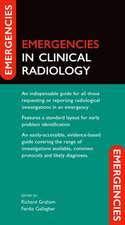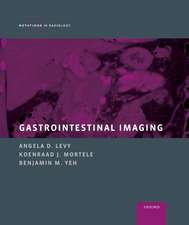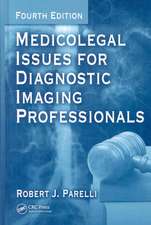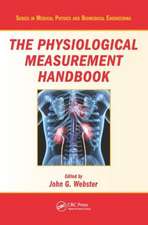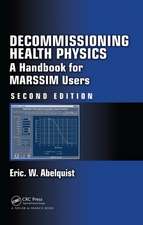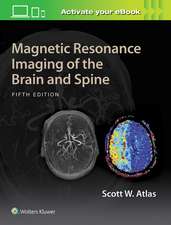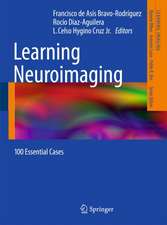Radiologic Technology Clinical Manual
Autor Robert J. Parellien Limba Engleză Hardback – 30 sep 2020
When used as part of an occupational training course in radiologic technology, the Radiologic Technology Clinical Manual will help students qualify for examination by the American Registry of Radiologic Technologists (ARRT). The book contains valuable record keeping materials for clinical experience hours, background on the profession as a whole, and evaluation forms for quarterly periods of clinical training. Time sheets, attendance forms, and clinical log forms are also included.
| Toate formatele și edițiile | Preț | Express |
|---|---|---|
| Paperback (1) | 693.16 lei 6-8 săpt. | |
| Taylor & Francis – 31 iul 1997 | 693.16 lei 6-8 săpt. | |
| Hardback (1) | 1090.18 lei 6-8 săpt. | |
| Taylor & Francis – 30 sep 2020 | 1090.18 lei 6-8 săpt. |
Preț: 1090.18 lei
Preț vechi: 1366.55 lei
-20% Nou
Puncte Express: 1635
Preț estimativ în valută:
208.67€ • 226.74$ • 175.40£
208.67€ • 226.74$ • 175.40£
Carte tipărită la comandă
Livrare economică 21 aprilie-05 mai
Preluare comenzi: 021 569.72.76
Specificații
ISBN-13: 9781138464919
ISBN-10: 1138464910
Pagini: 242
Dimensiuni: 210 x 280 mm
Greutate: 0.45 kg
Ediția:1
Editura: Taylor & Francis
Colecția CRC Press
Locul publicării:Oxford, United Kingdom
ISBN-10: 1138464910
Pagini: 242
Dimensiuni: 210 x 280 mm
Greutate: 0.45 kg
Ediția:1
Editura: Taylor & Francis
Colecția CRC Press
Locul publicării:Oxford, United Kingdom
Public țintă
ProfessionalCuprins
Preface -- Author -- Chapter 1: Introduction -- General Philosophy -- Clinical Coordinator -- Clinical Education Supervisor/Instructor -- Policy for Student Clinical Rotation Schedule -- Policy for Supervision of Clinical Students -- Definitions of Supervision -- Policy for Student Grades -- Grading Policy: Theory and Clinical -- Promotion -- Chapter 2: Clinical Education I -- Clinical Competency Objectives -- Course Outline -- Radiology Hospital Field Experience -- Student Objectives -- Method of Evaluation -- Work Assignments -- Reports -- Selection of Topic -- Work Assignment #1—Radiology Department Administrator -- Work Assignment #2—Reception Area -- Work Assignment #3—Darkroom Area -- Work Assignment #4—Fluoroscopy -- Work Assignment #5—General Radiology -- Chapter 3: Clinical Education II -- Instructional Objectives -- Course Outline -- Chapter 4: Clinical Competency Evaluations -- Purpose -- Objectives -- Evaluation -- Clinical Competency Evaluation Forms -- Chapter 5: Quarterly Clinical Evaluations -- First Quarter Evaluation -- Number of Examinations and Procedures -- Second Quarter Evaluation -- Student Self-Evaluation Second Quarter -- Second Quarter Evaluation Form -- Second Quarter Evaluation—Darkroom/Reception Area -- Number of Examinations and Procedures -- Third Quarter Evaluation -- Student Self-Evaluation Third Quarter -- Number of Examinations and Procedures -- Twelve-Month Evaluation -- Terminal Competency Log -- Number of Examinations and Procedures -- Chapter 6: Other Evaluation Procedures -- Evening/ Weekend Evaluation -- Nuclear Medicine -- Radiation Therapy -- Angiographic Evaluation -- CT/MRI Evaluation -- Medical Sonography Evaluation -- Chapter 7: Mammography Evaluation Forms -- Axillary View -- Cranio-Caudal Projection -- Cleopatra Projection -- Ductography -- Stereotactic Needle Localization -- Medial Lateral Oblique -- Pneumocystography -- Special Mammographic Views -- Tangential View -- Chapter 8: Monthly Attendance Record Procedure -- Monthly Attendance Record Forms -- Chapter 9: Clinical Education Guidelines -- Record of Procedures Forms.
Descriere
Both critic and writer, Stendhal has now become established as one of realism's founding fathers. Dr Pearson's book maps out, for the first time, the critical reception of Stendhal's two most widely read novels, The Red and the Black and The Charterhouse of Parma since their publication in 1830 and 1839 respectively. In part one he provides generous samples of the most important nineteenth-century responses to the novels, almost all of them translated into English for the first time. Part two presents a full range of the most authoritative and influential readings since 1945, which illustrate a wide variety of critical approaches.



